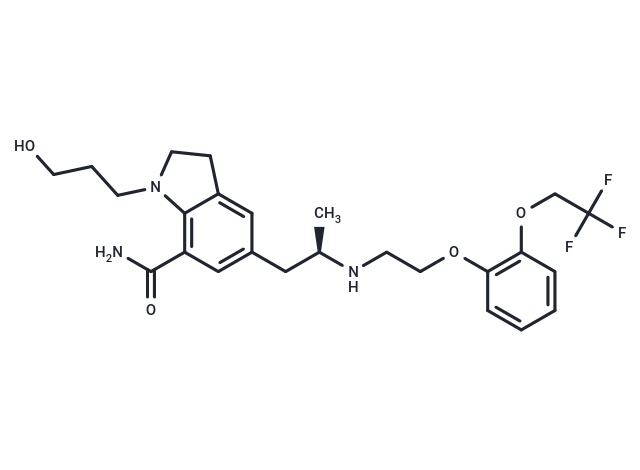Shopping Cart
- Remove All
 Your shopping cart is currently empty
Your shopping cart is currently empty

Silodosin (KAD 3213) is an alpha-Adrenergic Blocker. The mechanism of action of silodosin is as an Adrenergic alpha-Antagonist.

| Pack Size | Price | Availability | Quantity |
|---|---|---|---|
| 5 mg | $32 | In Stock | |
| 10 mg | $52 | In Stock | |
| 25 mg | $74 | In Stock | |
| 50 mg | $91 | In Stock | |
| 100 mg | $108 | In Stock | |
| 200 mg | $135 | In Stock | |
| 1 mL x 10 mM (in DMSO) | $36 | In Stock |
| Description | Silodosin (KAD 3213) is an alpha-Adrenergic Blocker. The mechanism of action of silodosin is as an Adrenergic alpha-Antagonist. |
| Targets&IC50 | α1D-adrenoceptor:2 nM (Ki), α1B-adrenoceptor:21 nM (Ki), α1A-adrenoceptor:0.036 nM (Ki) |
| In vitro | Silodosin (0.1-0.3 mg/kg) significantly reduces intralumenal ureteral pressure by 21-37% in obstruction-induced scenarios, whereas Phentolamine (0.03-0.1 mg/kg) can increase it by 18-40%. In dogs with benign prostatic hyperplasia, Silodosin (0.3-300 mg/kg) dose-dependently inhibits the increase in urethral pressure induced by pelvic nerve stimulation without notable hypotensive effects. In rabbit lower urinary tract tissues, Silodosin markedly antagonizes contractions induced by norepinephrine (including in the prostate, urethra, and bladder trigone, with PA(2) or pKb values of 9.60, 8.71, and 9.35, respectively). Oral administration of Silodosin in rats significantly inhibits the increase in urethral pressure caused by phenylephrine at 12 h, 18 h, and 24 h post-administration compared to the control group. Silodosin exhibits inhibitory effects on isolated contractions of rat and human ureters and possesses strong functional selectivity for relieving pressure in ureteral obstruction in rats. |
| In vivo | Silodosin and tadalafil synergistically inhibit neurally-mediated contraction effects in human and rat ex vivo prostates. Compared to tamsulosin hydrochloride, naftopidil, or prazosin hydrochloride, Silodosin exhibits higher selectivity for the α(1A)-AR subtype, with the affinity order being highest for tamsulosin hydrochloride, followed by Silodosin, prazosin hydrochloride, or naftopidil. |
| Alias | KMD 3213, KAD 3213 |
| Molecular Weight | 495.53 |
| Formula | C25H32F3N3O4 |
| Cas No. | 160970-54-7 |
| Smiles | C(CCO)N1C=2C(=CC(C[C@H](NCCOC3=C(OCC(F)(F)F)C=CC=C3)C)=CC2C(N)=O)CC1 |
| Relative Density. | 1.249 g/cm3 (Predicted) |
| Storage | Powder: -20°C for 3 years | In solvent: -80°C for 1 year | Shipping with blue ice. | |||||||||||||||||||||||||||||||||||
| Solubility Information | DMSO: 92 mg/mL (185.66 mM), Sonication is recommended. Ethanol: 92 mg/mL (185.66 mM), Sonication is recommended. | |||||||||||||||||||||||||||||||||||
Solution Preparation Table | ||||||||||||||||||||||||||||||||||||
DMSO/Ethanol
| ||||||||||||||||||||||||||||||||||||

Copyright © 2015-2025 TargetMol Chemicals Inc. All Rights Reserved.